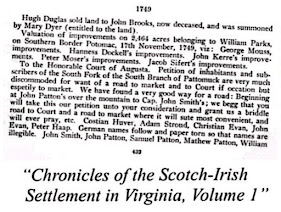In 1761 what is now Pendleton County (at that time still part of Augusta County), in what is now West Virginia, was on the edge of the Western Frontier. At this time the French and Indian War is just ending in the American Colonies. Adam Stroud is said to have served as a scout in the French and Indian War in the work; "By the Banks of the Holly: Notes and Letters from the Desk of Bernard Mollohan." This is the only source for Adams potential service in the French and Indian War and cannot be used as a primary source to prove his service as a scout, though it may explain why it is Adam Stroud was able to purchase 275 acres of land immediately after the end of the war.
We know from an Augusta County petition that Adam Stroud was living on the South Branch of the Potomac River in Augusta County in 1749, 5 years before the outbreak of war and appears in Hampshire County, created from part of Augusta county in 1753, in the Colonial Census of 1755, one year after the outbreak of the war. Adam Stroud appears to have lived on the South Branch of the Potomac throughout the French and Indian War. The South Branch of the Potomac River was the site of several battles during the French and Indian War, including the Battle of the Trough in 1756. The Battle of the Trough was a skirmish between Native Americans and Anglo-American settlers in the South Branch valley, which is now northern Hardy County, West Virginia. In 1756, George Washington directed the construction of a fortification at Fort Pleasant, which is located about a mile and a half away from the Battle of the Trough.
Though the war with France had ended, the backcountry of Virginia remained a wild frontier still inhabited by hostile Indian tribes. Pendleton County was just East of the Proclamation Line of 1763. On October 7", 1763, a Royal Proclamation prohibited al settlement west of a line drawn down the length of the Appalachian Mountains. Many settlers would begin moving west of this line following new treaties between the Natives and Colonists in 1768.
On March 22nd, 1769, Chalkley's "Chronicles" records the naturalization of Adam Stroud. His being naturalized is evidence that he was, in fact, not born in America. There is no record of Peter Stroud having ever been naturalized.
Just eight days after being naturalized, the "Chronicles" records the sale of Adam Stroud's 275 acres to Bastian Hover for £24 on March 30th, 1769. This record also mentions a "Mary Stroud" in association with Adam Stroud. This is the one and only place Mary is mentioned in any sources, both primary and secondary, relating to Adam Stroud. It is not clear exactly who Mary was. If she was an earlier wife of Adam Stroud, they do not appear to have had any children. It is possible that Mary was the name of Adam and Peters mother, and that her name was attached to the property title. This is only speculation.
By 1769 Peter Stroud had married and had 7 children. Adam Stroud seems to have been single and childless when the brothers set out across the old Proclamation Line and into Kanawah County, Virginia, where Adam and Peter Stroud were the first white settlers. As noted by land claims in Chalkley's "Chronicles" they settled just east of the Indian Territory on neighboring plots on the Gauley River at the junction with what is now known as Stroud's Creek, just west of present-day Camden on the Gauley. Each brother built for himself a cabin on his plot and carved out a living on the frontier for 4 years until June of 1772.
“A Borderman of Northwestern Virginia” artwork is from the work “The Border Settlers of Northwestern Virginia” by Lucullus Virgil McWhorter.









No comments:
Post a Comment